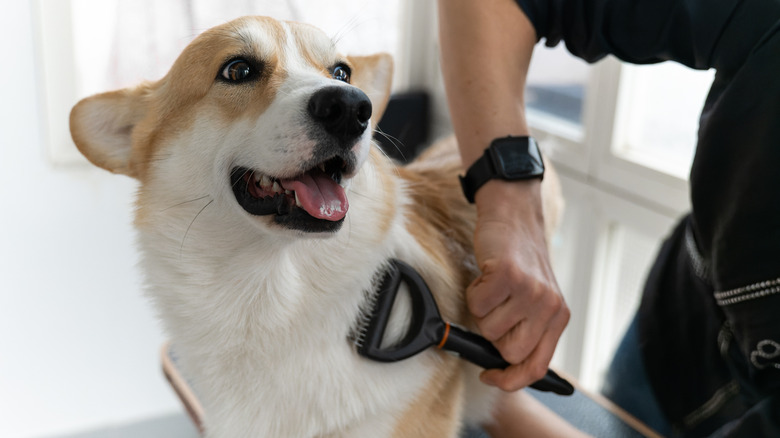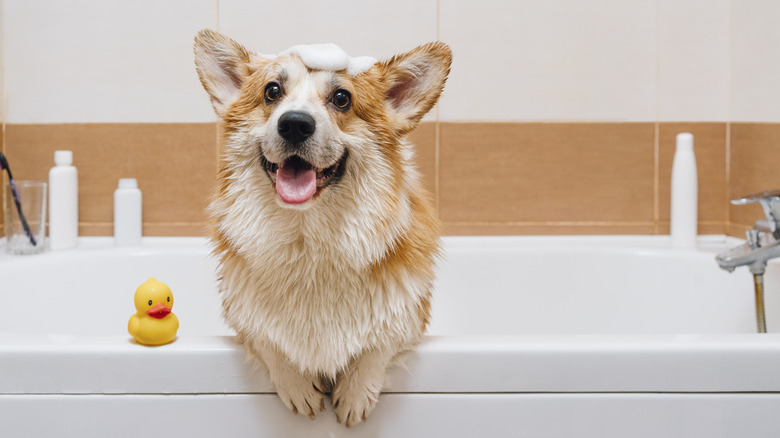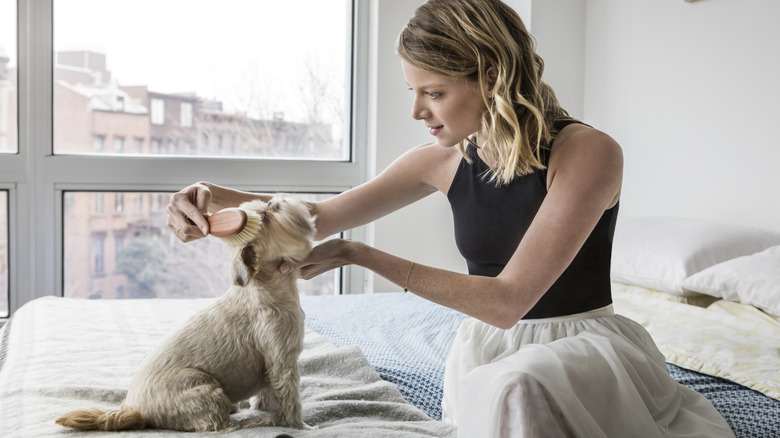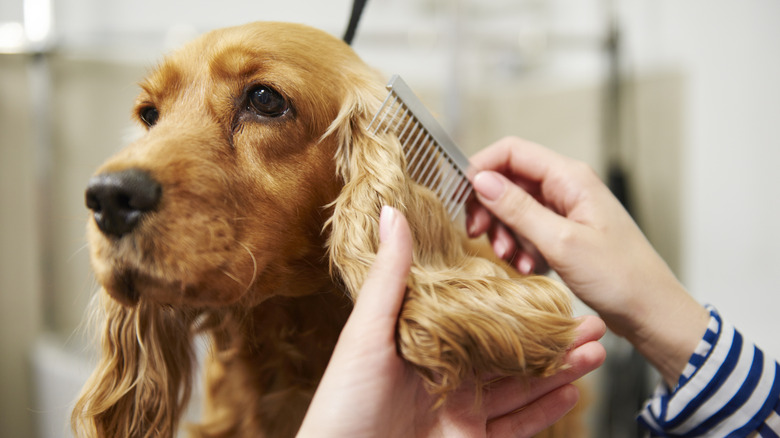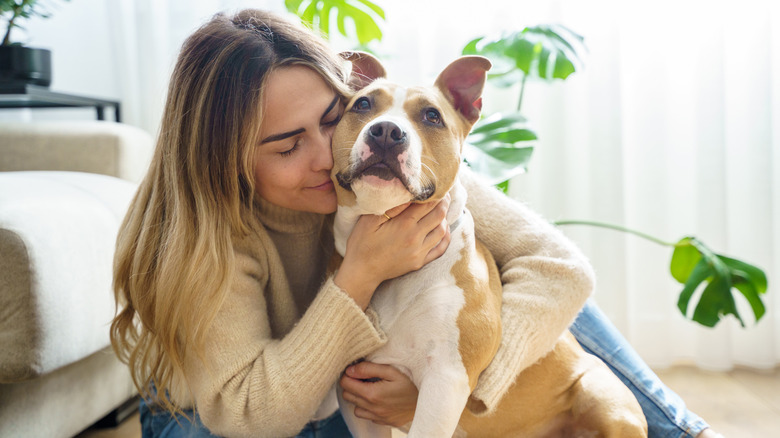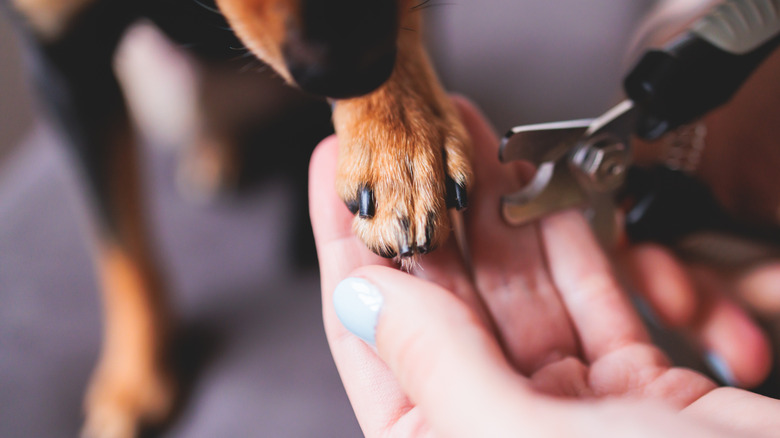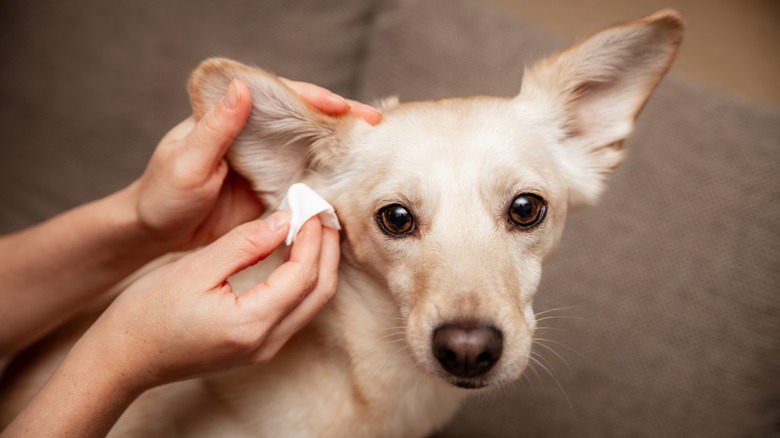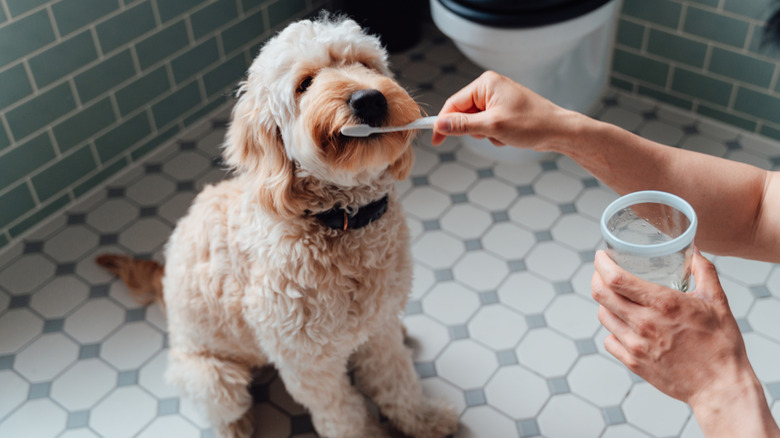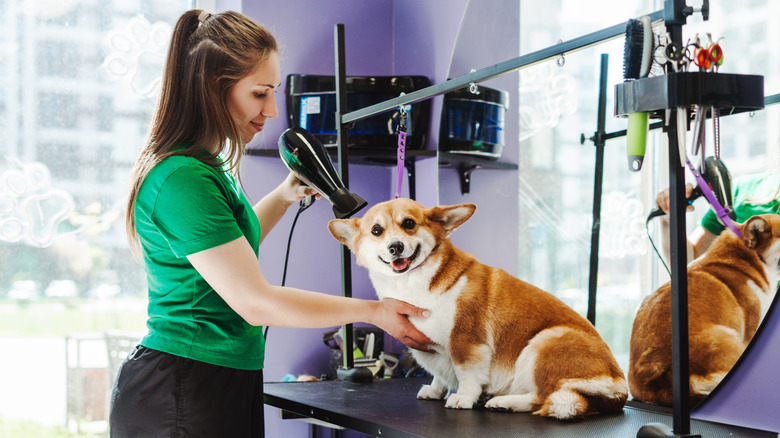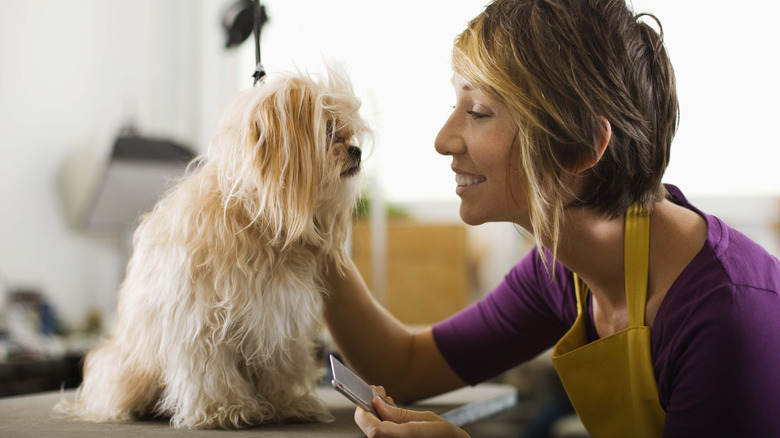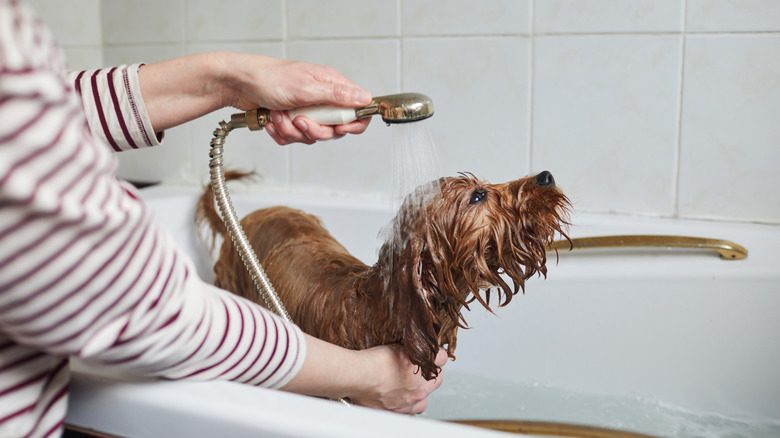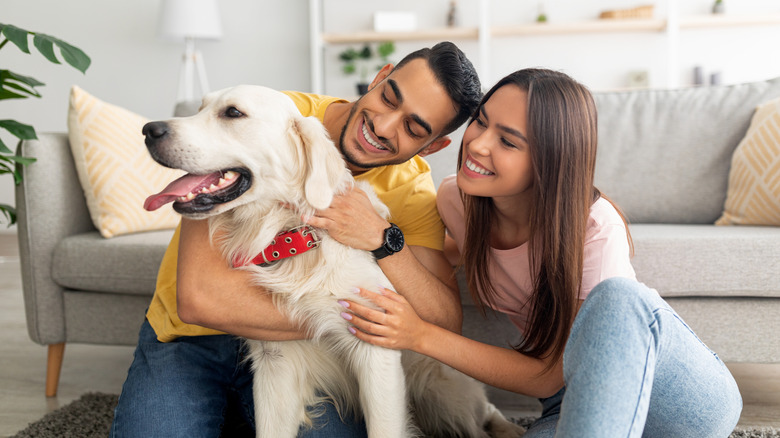11 Tips To Save Money On Dog Grooming
We may receive a commission on purchases made from links.
Every pet parent knows to budget for essentials like kibble and veterinary care, but grooming is often an unforeseen expense that adds up quickly. Based on a 2024 survey completed by USA Today, annual grooming costs for dogs range between $60 and $500 on average. Caretakers of certain breeds, like poodles, Afghan hounds, and Maltese may find themselves spending significantly more on regular haircuts.
While a trip to the groomer leaves your pup looking and smelling their best, it's about much more than treating them to a spa day. In fact, regular grooming is essential to your pet's health, and skipping an appointment to save money could lead to an even pricier vet bill down the line. For example, overgrown nails from irregular trimming can cause infections and joint problems like arthritis. Dogs with longer coats will develop matting without consistent care, which can quickly result in serious skin issues.
Many dog parents have found success taking steps at home to make costly spa trips less frequent or even eliminate the need for professional grooming entirely. With the right training, some essential tools, and a few tricks up your sleeve, it's entirely possible to stay on top of your pup's grooming needs without going over budget.
Train your dog to love being groomed
Getting your dog comfortable with grooming makes it easier to handle touch-ups at home and reduces costly time with a professional. Trying to lather up a pup who hates bath time or clip a wriggly dog's nails will likely be a stressful experience for both you and your pet. While professional groomers are trained to handle uncooperative animals safely, some may charge a premium or even refuse to work with canines who become particularly anxious or aggressive on the table.
With a bit of patience and consistency, many dogs can learn to tolerate and even enjoy grooming time. This is much easier to achieve when starting as young as possible, first getting your puppy used to being handled and gradually working towards more specific tasks like brushing and nail trimming. Be sure to use plenty of positive reinforcement, such as treats and praise, to build your dog's confidence along the way.
Starting this type of training early isn't always realistic, especially with rescues who find their forever home in adulthood. Grooming training is still perfectly achievable for older dogs but may require a bit more time and patience. For instance, to introduce nail trimming, start slowly by touching their paws and nails and rewarding them each time. As they become more comfortable, begin to apply more pressure with your fingers before moving to clippers. It may be helpful to trim one nail at a time until they can tolerate a longer session.
Brush your dog's coat regularly
Regular brushing is essential to maintain the health of your dog's coat, keep shedding at bay, and prevent matting. The recommended frequency and benefits of a brushing routine depend on the type of coat your dog has. It's also important to pick the right brush for your dog's coat. Short-haired dogs are best suited to softer options like bristle brushes and rubber mitts, which are designed to smooth fur without irritating your pup's skin. If your dog has longer hair, you'll need a brush designed to prevent matting, such as an undercoat rake.
Short-haired dogs like terriers, pitbulls, and labs should have their coats brushed on a weekly basis. Since they also tend to shed, regular brushing helps eliminate loose fur before it sticks to the sofa. While increasing brushing frequency to a few times per week for de-shedding purposes is okay, be wary of over-brushing your dog and potentially causing painful skin irritation.
On the other hand, dogs with double coats or longer hair, such as poodles and Yorkshire terriers, need daily brushing to avoid tangles. When left for too long, tangles will eventually develop into mats, a more serious condition that can severely impact your pet's health. As matting progresses, it has the potential to cause skin rashes, harbor fleas and ticks, or even require surgery in the most extreme cases. Mats are extremely difficult to remove without cutting them out, so it's best to get tangles out early.
Detangle with cornstarch
Even dogs that undergo a regular brushing routine can develop problem areas that don't detangle easily with a comb. Trying to brush these areas for too long may be uncomfortable or painful for your pup. If you're facing stubborn tangles or mats, try sprinkling a small amount of cornstarch on the area and massaging it in with your fingers. You may find that the tangle slips apart easily without the need for vigorous brushing.
Cornstarch is a highly effective and budget-friendly alternative to expensive detangling products. It's also safe to use around your dog, causing no known potential health effects if ingested. It works best when paired with an appropriate detangling or dematting tool, like a Maxpower Planet Double-Sided Dematting Undercoat Brush or Poodle Dematting Fur Rake.
Should your pup develop severe matting that doesn't respond to treatment at home, don't wait too long to bring them to a professional groomer or your veterinarian. Some mats may need to be removed by a pro to prevent injury to your dog. This typically involves using an electric shaver to completely remove all hair in the affected area.
Use baking soda for odor control
If you notice your pup getting a bit stinky between baths, odors trapped in their fur could be the culprit. Baking soda is a natural dog-friendly deodorant that most pet parents can find in their kitchen. It's surprisingly effective at neutralizing the oils and bacteria that cause unwanted smells, making it a great low-cost dry shampoo.
To keep your dog smelling fresh, sprinkle a small amount of baking soda into their fur and give it a few minutes to sit. Follow with a thorough brushing and rub down with a towel to remove any remaining baking soda. For an easier cleanup, you may want to do this outside. Baking soda can also be mixed at a 1:1 ratio with cornstarch to make a one-step deodorizing and detangling powder.
Just keep in mind that while baking soda is safe in small quantities, it can make your dog sick if they ingest a large amount. According to American College of Veterinary Pharmacists, toxic quantities start at 1-2 teaspoons per pound of body weight, which means a 15-pound dog would need to eat more than ¼ cup of baking soda to experience potential health effects. Meanwhile, a 50-pound dog could get sick from ingesting at least 1 cup. Always keep baking soda containers out of your dog's reach and call the vet if they ingest a large quantity or experiences symptoms like vomiting, diarrhea, lethargy, or seizures.
Learn how to trim your pup's nails at home
Nail trimming can be one of the most daunting dog grooming tasks to master. Not only do many pups find nail care off-putting and try to squirm away from the clippers, but cutting just a sliver too far can mean hitting your dog's quick. The quick is the fleshy interior of the nail that includes blood vessels and nerves; if inadvertently cut during nail trimming, your canine may yelp in pain and even bleed. You can typically see the outline of the quick on clear nails, but you'll face an additional challenge in determining how far to cut if your dog's nails are black.
To safely cut your pup's overgrown nails, use canine nail trimmers to take off just a millimeter at a time until you begin to see the tip of the quick. This will appear as a white circle on the tip of your dog's nail. As an alternative, you can use a nail file or electric grinder to shorten nails without cutting. Trimming nails once a month at home can reduce the need for trips to the groomer. If you're looking for highly-rated nail trimming tools, consider the LED Dog Nail Clipper with Light or Casfuy Dog Nail Grinder.
Include ear care in your home grooming routine
Some dogs are susceptible to ear infection without the appropriate preventive care. While any pup can get an ear infection, poodles, spaniels, and other breeds with long, floppy ears seem to be more prone to chronic issues. Integrating ear care into your dog's grooming routine is a great way to avoid expensive vet visits to treat infections by preventing them before they happen. If your dog has particularly long or thick ear hair, they may also benefit from having those hairs plucked to stop infections from forming. However, this practice has become somewhat controversial in recent years, so it's best to ask your vet for their opinion.
If your dog's ears begin to emit an off-putting odor or seem to be itchier than usual, it might be time for a cleaning. The ear flap, which is the flat part of your dog's ear that either sticks up or hangs down, can be cleaned with an at-home dog ear cleaning solution made from a 1:1 ratio of white vinegar and water. Soak a cotton swab in the solution and wipe down the ear flap, taking care not to get any vinegar in your dog's ear canal. Your vet can recommend a professional cleaning solution for use deeper within the ear. However, if you notice more severe symptoms like discharge, scabbing, redness, a stronger odor, or your dog appears to be in pain, your pup may already have an active ear infection. Since at-home ear cleaners are not effective at treating infections, it's best to seek prompt veterinary attention when an ear infection is suspected.
Don't neglect oral hygiene
Just like their humans, dogs need regular dental care to maintain their oral health. Routinely brushing your dog's teeth helps prevent issues like gingivitis and periodontal disease, both of which can lead to tooth loss in their later years. Unfortunately, the vast majority of dogs don't receive the dental care they require, and more than four in five will suffer from periodontal disease during adulthood, per VCA Animal Hospitals. Veterinarians often have to extract teeth from dogs with a lifetime of poor oral hygiene, charging between $500 and $2,500 per tooth for the procedure. If your dog loses too many teeth, you'll also need to provide them with a pricey special soft diet.
To do a thorough job brushing your dog's teeth, start by gently lifting their lips and brushing the outside of their teeth in the front and on both sides. As they become more comfortable, move on to brushing the tooth surfaces and the inside of both the top and bottom teeth. You should brush your dog's teeth at least three times per week as a bare minimum, although daily brushing is ideal.
Many dental tools and flavored toothpastes are available to make the experience as enjoyable as possible for your dog, such as the Dog Finger Toothbrush and Peanut Flavor Petrodex Toothpaste. Your dog's oral health doesn't end with regular brushing, however. Dental chews and chew toys made from plastic or rubber are also effective at removing plaque, not to mention more fun for your dog.
Look for smaller local groomers
Even with nail trims and touch-ups at home, most dogs will need to visit a professional groomer at least occasionally. When it's time for your pup's next appointment, try looking for independent groomers and small, locally-owned services. While many dog parents turn to national chains for brand recognition and the convenience of online booking, they often charge significantly more than local shops. Additionally, smaller groomers are more likely to be flexible on pricing and custom services. For example, if you're on a tight budget, you might be able to negotiate a deal with a local grooming service to bring your pup in just after a thorough bath and brush to only receive a basic trim.
Since dog grooming prices vary by geographic location, the only way to find out for sure is to compare quotes in your area. Call around to gather pricing information before scheduling your pup's next appointment. Don't forget to ask about cost-saving opportunities like adding or removing individual services as needed or bringing your dog in already bathed.
Prep your dog for grooming appointments
One of the major factors that goes into the cost of professional grooming is the amount of time that must be allocated to each dog. A groomer's standard pricing typically covers brushing, bathing, nail clipping, and hair trimming for an average canine that receives regular maintenance care as needed. If you bring your dog into the salon after falling behind on upkeep for an extended period, you should be prepared for the possibility of paying extra for the groomer's time.
Most groomers list an additional fee for dogs that require excessive de-matting or detangling. This may be a flat fee or an hourly rate for the time spent on problem areas. The best way to avoid extra charges is to bring your dog in without major issues like matting or severely overgrown nails. Give them a thorough wash and brush before their appointment to ensure your groomer doesn't have to allocate any additional time to their care.
You can also save your groomer time by making sure your dog gets plenty of exercise in the hour or two before their appointment. Grooming can be a frustrating experience for pups, particularly those with excess energy. A long walk or play period at the dog park can help tire them out and make things smoother for both the groomer and the canine.
Visit a self-serve dog wash
Those who opt to try DIY grooming at home can face challenges due to the lack of proper equipment and may be shocked by the cost of products like dog shampoo and detangler. If home care isn't doing the job but a professional groomer is out of your budget, a self-service pet wash might be worth trying. These washes offer pet-friendly bathing facilities and access to professional grooming products, sometimes for as little as $10 or $20.
You can expect to find individual washing stations stocked with shampoo and conditioner, brushes, hair dryers, and clean towels. Many are walk-in friendly and don't require a prior appointment. In addition to saving money, you'll also save time cleaning up a mess in the bathroom. While self-service pet washes make many products available to customers, they aren't likely to supply sharp tools like nail clippers or hair scissors. Thankfully, some are housed in the same location as professional groomers, making it easy to schedule essential services like nail trimming in the same trip.
Get help from a friend or family member
If your dog is particularly fearful of grooming or still getting used to being handled, ask a friend or family member to help with home grooming tasks like nail trimming and tooth brushing. Having a second person to assist can help prevent slips and injury for both you and your dog.
To complete grooming with assistance, supply your friend or family member with a generous handful of treats and ask them to hold your pup gently but firmly in place. Have them distract the dog with rewards and praise while you tackle grooming tasks. If the dog starts to panic or resist too much, step back and take a break before resuming. Don't use excessive force to hold a scared pup in place; this will only create aversion to future grooming sessions and could negate progress you've already made.
Most importantly, don't attempt home grooming with a dog that has a history of aggression or biting. To protect everyone's safety, it's best to continue working on training and leave the grooming to the professionals in the meantime. Be sure to disclose your dog's behavioral history before showing up for a professional grooming appointment.
